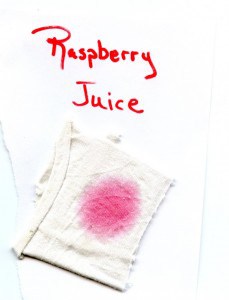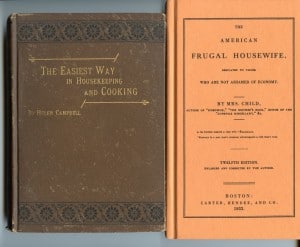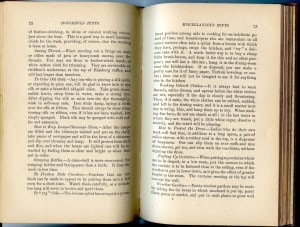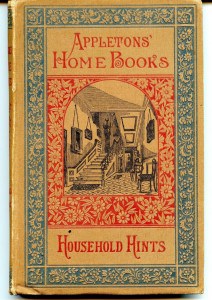Stain Removal, Now and Then
By Karen Osburn, Archivist
The other day I was eating some cherries for lunch and a particularly juicy one squirted on my shirt. My shirt was red, but the cherries were almost purple and left some spots on a favorite piece of clothing. As I was berating myself for not having a stain stick or Tide pen with me to take care of the stain the question crossed my mind, “how did people handle stains in the days before colorfast bleach, Stain Stick, Tide Pens and laundry detergent”? I remember my mother telling me to use cold water for chocolate and blood and hot water for any type of fruit stain, but how did people in the 1880s handle mud, grass stains, manure, blood from slaughtering, bear grease, goose grease etc.? We have the books on hand so I thought I would do a bit of research to see what the experts of the 19th century suggested.
The first source I reviewed was The American Frugal Housewife, Dedicated to Those Who Are Not Ashamed of Economy, written by Lydia Maria Child in 1833. The author lists several remedies for stains, one dealing with ink spots. She recommends soaking the spot in milk before the ink has a chance to dry. If the ink is already dry she instructs you to rub table salt on it and drop lemon juice upon the salt. For grease spots she gives a recipe of magnesia rubbed upon the spot, then covered with clean paper, and followed by a warm iron placed above (on?) the paper. This is supposed to draw the grease out, though she does say that where a large amount of oil has been spilled it will be necessary to repeat the operation several times.
She devotes two pages to dye-stuffs for various colors, which made me wonder if stains were not considered as much of a problem as they are today.
Another book I consulted was Common Sense in the Household: A manual of Practical Housewifery, by Marion Harland, published in 1874. Ms. Harland has many suggestions on how to clean clothes from woolens, to silk, to “Doubtful Calicoes”. To remove grease spots from silk she offers the method of scraping Venetian of French Chalk and moistening it to a stiff paste with soap-suds, making that mixture into cakes and pressing them between two boards and drying them in the sun or an oven.
Once you have a spot of grease on your dress, take a cake and scrape it to powder to cover the spot. Then lay the silk on a clean linen or cotton cloth and cover the chalk powder with two or three layers of tissue paper and press it with a hot iron for a minute or more, being careful the iron doesn’t touch the silk. Finally lift the tissue and scrape off the grease with the chalk.
Marion Harland has instructions for restoring the pile of velvet, curling tumbled feathers, clean straw matting, washing lawn or thin muslin, woolens, white lace edging, black lace, cleaning cloth coats, putting away furs and woolens for the winter, cleaning very dirty black dresses, dealing with “iron mould” (rust), mildew, ink, acid or alkali stains, and grease spots. Marion’s recipe for removing grease spots called for boiling water, pulverized borax and gum camphor. This was said to be excellent for removing grease from woolens.
Two different recipes, one from 1827 for removing grease spots and one from 1870s for removing acid stains, call for “hartshorn”, made from the horns of the male red deer. This apparently had ammonia-like properties when properly prepared and could be used like a detergent.
One book by Helen Campbell dated 1881, The Easiest Way in Housekeeping and Cooking, devotes pages to washing day. It discusses everything from the clothesline, (rope should be brought in after every use so as not to become weather-stained and damage a garment), to fruit stains which should be treated with boiling water. Ms. Campbell suggests treating iron rust by spreading the garment in the sun, applying salt and lemon juice enough to wet the salt. She also gives directions on how to wring the clothes, usually a mechanical wringer is recommended as opposed to hand wringing. There is a mention of using butter to remove machine-oil, which is a puzzle, grease to remove grease? There is also the admonition never to rub soap directly on a stain as you will cause it to set.
No wonder one day of the week was usually set aside to do laundry in the 19th century. The amount of preparation and knowledge one needed to tackle, what seems today to be quite an easy task, was formidable. Remember there was seldom running water and no hot water heaters in the early to mid-1800s. Water had to be carried in buckets and heated over a fire, and then there was pre-treatment of stains.
No, I know I would rather be dealing with stains and laundry today than over 100 years ago. It is so easy to just treat a stain with a stick, or a spray and put the dirty clothes in a machine that washes and removes most of the water in one step. I think I will just write myself a note to bring a stain stick to work and continue eating the fresh fruits of summer.
Tagged With: 1800s, Karen Osburn




